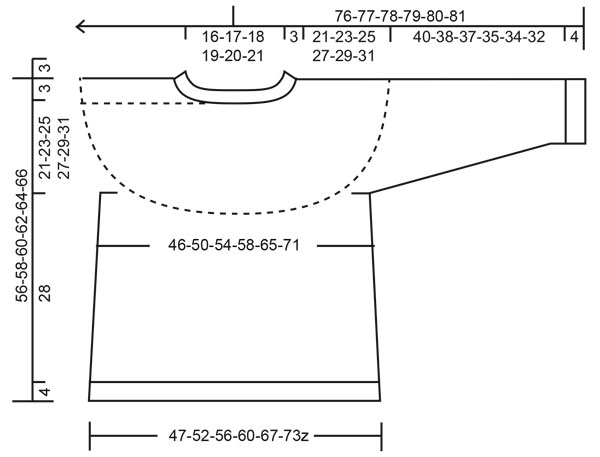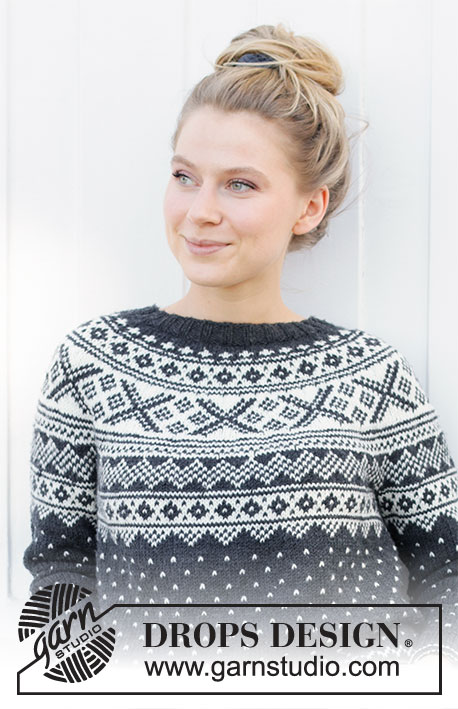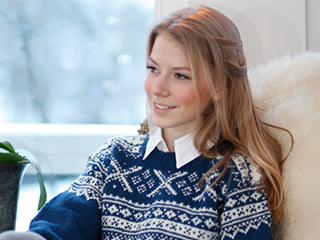Winter's Night Enchantment |
|||||||||||||
 |
 |
||||||||||||
Knitted jumper in DROPS Merino Extra Fine. Piece knitted top down with round yoke and Nordic pattern. Size: S - XXXL
DROPS 217-10 |
|||||||||||||
|
------------------------------------------------------- EXPLANATION FOR THE PATTERN: ------------------------------------------------------- INCREASE TIP (evenly): To calculate how to increase evenly, use the total number of stitches on row (e.g. 92 stitches) and divide stitches by number of increases to be done (e.g. 28) = 3.3. In this example increase by making 1 yarn over after approx. every 3rd stitch. On next round knit yarn overs twisted to avoid holes. ELEVATION (in back of neck): To make the jumper higher in the back of neck when working round yoke work an elevation as explained below. Skip this paragraph if you do not want an elevation. Insert 1 marker at beginning of round = mid back. Begin from right side with dark grey and knit 12-13-14-15-15-16 stitches past marker, turn, tighten yarn and purl 24-26-28-30-30-32. Turn, tighten yarn and knit 36-39-42-45-45-48, turn, tighten yarn and purl 48-52-56-60-60-64. Turn, tighten yarn and knit 60-65-70-75-75-80, turn, tighten yarn and purl 72-78-84-90-90-96, turn, tighten yarn and knit until mid back. Then work YOKE as explained in pattern. PATTERN: See diagrams A.1 to A.4. Choose diagram for your size (applies to A.1 and A.2). Work the entire pattern in stocking stitch. KNITTING TIP: To avoid the knitting tension to tighten when working pattern, it is important not to tighten the strands on back side of piece. Switch to a higher needle number when working pattern if the pattern is somewhat tight. If the knitting tension is too tight vertically, the garment will be too short and the armhole will be too small - this can be adjusted by working 1 row more evenly in the sections with one colour. If the knitting tension is too loose vertically, the garment will be too long and the armhole too big, this can be adjusted by working 1 row less in the sections with one colour. DECREASE TIP (applies to mid under sleeves): Decrease 2 stitches mid under sleeve as follows: S: Work until 2 stitches remain before marker mid under sleeve, knit 2 together with dark grey, marker, knit 2 twisted together stitch with dark grey (= 2 stitches decreased). M, L, XL, XXL and XXXL: Work until 2 stitches remain before stitch with marker, knit 2 together with dark grey, knit stitch with marker with dark grey, knit 2 twisted together with dark grey (= 2 stitches decreased). CAST-OFF TIP: To avoid a tight cast-off edge you may use a larger needle size. If this also is too tight, work a 1 yarn over after approx. every 4th stitch while casting off (cast off yarn overs as regular stitches). ------------------------------------------------------- START THE PIECE HERE: ------------------------------------------------------- JUMPER - SHORT OVERVIEW OF THE PIECE: Work neck edge and yoke in the round on circular needle from mid back, top down. Now divide yoke for body and sleeves. Body is worked in the round from the side, top down. Work sleeves in the round on double pointed needles/short circular needle, top down. NECK EDGE: Cast on 92-96-100-104-108-112 stitches on a short circular needle size 3 mm with dark grey. Knit 1 round. Then work rib in the round (= knit 2/purl 2) for 3 cm. Switch to circular needle size 4 mm. Knit 1 round while increasing 28-28-32-32-36-40 stitches evenly - read INCREASE TIP = 120-124-132-136-144-152 stitches. Insert 1 marker mid front, measure yoke from this marker! Now work an ELEVATION in the back of neck - read explanation above. If you do not want an elevation, skip directly to YOKE. YOKE: Work 0-0-2-2-4-6 rounds in stocking stitch with dark grey. Read KNITTING TIP, and work A.1 in the round (= 30-31-33-34-36-38 repetitions of 4 stitches). Continue pattern like this but when A.1 has been worked vertically, work A.2 the same way. REMEMBER THE KNITTING TENSION! AT THE SAME TIME on every round marked with arrow in A.1 and A.2 increase stitches evenly as explained below - remember INCREASE TIP: SIZE S, M and L: Arrow-1: Increase 36-38-42 stitches evenly = 156-162-174 stitches (there is now room for 26-27-29 repetitions of 6 stitches). Arrow-2: Increase 64-58-66 stitches evenly = 220-220-240 stitches (there is now room for 11-11-12 repetitions of 20 stitches). Arrow-3: Increase 32-40-36 stitches evenly = 252-260-276 stitches (there is now room for 63-65-69 repetitions of 4 stitches). Arrow-4: Increase 30-34-36 stitches evenly = 282-294-312 stitches (there is now room for 47-49-52 repetitions of 6 stitches). Arrow-5: Increase 24-30-36 stitches evenly = 306-324-348 stitches (there is now room for 51-54-58 repetitions of 6 stitches). Arrow-6 (only applies to M and L since S is divided for body and sleeves before this border begins): Increase 4-4 stitches evenly = 306-328-352 stitches (there is now room for 41-44 repetitions of 8 stitches in M and L). SIZE XL, XXL and XXXL: Arrow-1: Increase 44-48-52 stitches evenly = 180-192-204 stitches (there is now room for 30-32-34 repetitions of 6 stitches). Arrow-2: Increase 42-48-54 stitches evenly = 222-240-258 stitches (there is now room for 37-40-43 repetitions of 6 stitches). Arrow-3: Increase 18-20-22 stitches evenly = 240-260-280 stitches (there is now room for 12-13-14 repetitions of 20 stitches). Arrow-4: Increase 60-64-68 stitches evenly = 300-324-348 stitches (there is now room for 75-81-87 repetitions of 4 stitches). Arrow-5: Increase 54-54-60 stitches evenly = 354-378-408 stitches (there is now room for 59-63-68 repetitions of 6 stitches). Arrow-6: Increase 30-30-30 stitches evenly = 384-408-438 stitches (there is now room for 64-68-73 repetitions of 6 stitches). Arrow-7: Increase 8-8-10 stitches evenly = 392-416-448 stitches (there is now room for 49-52-56 repetitions of 8 stitches. ALL SIZES: Work until piece measures 21-23-25-27-29-31 cm from marker in neck. NOTE! In some size some rounds of A.2 will remain when piece is knitted for body and sleeves - finish the rest of A.2 on body and sleeves. Divide the yoke for body and sleeves as follows: Work 45-49-52-57-63-69 stitches as before (= ½ back piece), slip the next 63-66-72-82-82-86 stitches on 1 stitch holder for sleeve, cast on 6-6-8-8-10-10 new stitches on row (= in the side under sleeve), work 90-98-104-114-126-138 stitches as before (= front piece), slip the next 63-66-72-82-82-86 stitches on 1 stitch holder for sleeve, cast on 6-6-8-8-10-10 new stitches on row (= in the side under sleeve) and work the 45-49-52-57-63-69 stitches as before (= ½ back piece). Finish body and sleeves separately. NOW MEASURE PIECE FROM HERE! BODY: = 192-208-224-244-272-296 stitches. Finish A.2 - make sure that pattern fits nicely over A.2 on yoke but note that pattern does not fit under sleeves in all sizes when working the last rounds in A.2. When A.2 has been worked, work A.3 in the round - AT THE SAME TIME on first round increase 6-8-10-8-10-10 stitches evenly = 198-216-234-252-282-306 stitches on needle. There is now room for 33-36-39-42-47-51 repetitions A.3 of 6 stitches. Repeat A.3 vertically until piece measures approx. 22 cm from division in all sizes, but finish after a round with dots. Approx. 10 cm remain until finished measurements, try the jumper on and work A.3 in the until desired length. Work A.4 in the round – AT THE SAME TIME on first round increase 2-0-2-0-2-2 stitches evenly = 200-216-236-252-284-308 stitches on row (there is now room for 50-54-59-63-71-77 repetitions A.4 of 4 stitches). When A.4 has been worked, piece measures approx. 28 cm from division. Work the rest of the body in dark grey. Knit 1 round while increasing 48-52-56-60-68-72 stitches evenly = 248-268-292-312-352-380 stitches. Increase stitches to avoid the rib from contracting when working the piece together. Switch to circular needle size 3 mm. Work rib in the round = knit 2/purl 2 for 4 cm. Cast off with knit over knit and purl over purl - read CAST-OFF TIP. Jumper measures approx. 56-58-60-62-64-66 cm from shoulder and down. SLEEVES: Slip the 63-66-72-82-82-86 stitches from stitch holder in one side of piece on double pointed needles or a short circular needle size 4 mm – pick in addition up 1 stitch in each of the 6-6-8-8-10-10 stitches cast on under sleeve = 69-72-80-90-92-96 stitches. Now insert 2 markers in piece (this is done without working the stitches): S: Insert 1 marker mid under sleeve between the middle 6 stitches, count 34 stitch, insert 1 marker in next stitch = 34 stitches remain on round after stitch with marker. M, L, XL, XXL and XXXL: Begin mid under sleeve between the 6-8-8-10-10 stitches, insert 1 marker in the first stitch after the middle, count 35-39-44-45-47 stitches, insert 1 marker in next stitch = 35-39-44-45-47 stitches remain on round after stitch with marker. ALL SIZES: Move markers upwards when working. Use marker later when decreasing mid under sleeve. Use marker mid on top of sleeve when counting out where pattern should start. Then work PATTERN at the same time DECREASE mid under sleeve as explained below - read the rest of sleeve before continuing: PATTERN: Begin round mid under sleeve and finish A.2 the same way as on body, but count outwards from the middle of sleeve where pattern should begin - stitch with marker mid on top of sleeve should fit stitch marked with star in A.2 (decrease under sleeve while working the pattern). When A.2 has been worked, work A.3 in the round the same way. Repeat A.3 vertically until sleeve measures approx. 34-32-31-29-28-26 cm from division, but finish after a round with dots. NOTE! Shorter measurements in the larger sizes because of wider neck and longer yoke. Approx. 10 cm remain until finished measurements, try the jumper on and work A.3 in the until desired length. Then work A.4 in the round. DECREASE: At the same time when sleeve measures 3 cm from division in all sizes, decrease 2 stitches mid under sleeve - read DECREASE TIP. Decrease like this every 3-2½-2-1½-1½-1½ cm 12-13-16-20-20-20 times in total = 45-46-48-50-52-56 stitches. When A.4 has been worked, and decreases are done, sleeve measures approx. 40-38-37-35-34-32 cm from division. Work the rest of the sleeve with dark grey. Knit 1 round while increasing 7-6-8-10-8-8 stitches evenly = 52-52-56-60-60-64 stitches. Switch to double pointed needles size 3 mm. Work rib in the round = knit 2/purl 2 for 4 cm. Cast off with knit over knit and purl over purl - remember CAST-OFF TIP. Sleeve measures approx. 44-42-41-39-38-36 cm from division. Work the other sleeve the same way. |
|||||||||||||
Diagram explanations |
|||||||||||||
|
|||||||||||||

|
|||||||||||||

|
|||||||||||||

|
|||||||||||||
|
Have you made this or any other of our designs? Tag your pictures in social media with #dropsdesign so we can see them! Do you need help with this pattern?You'll find tutorial videos, a Comments/Questions area and more by visiting the pattern on garnstudio.com. © 1982-2024 DROPS Design A/S. We reserve all rights. This document, including all its sub-sections, has copyrights. Read more about what you can do with our patterns at the bottom of each pattern on our site. |
|||||||||||||








































































Comments / Questions (40)
In the tutorial video on how to knit an elevation, the first purl stitch is slipped but it doesn’t say to do that in the pattern. Should this stitch be slipped?
04.04.2024 - 09:41DROPS Design answered:
Dear Hannah, when working short rows slipping the first stitch will avoid holes, but feel free to use any other technique if you like. Happy knitting!
04.04.2024 - 12:50Hello! Could you tell, why is the collar (around the neck) so wide on the photo, in comparison to my work? My sweather is very close to neck, but I would love for it to be more loose like on the Drops photo. Same problem/question with the men's sweather... Thank you!
01.09.2023 - 21:01DROPS Design answered:
Dear Julia, the collar should measure 17 cm on the photo (which should be a size M). You also work a rib in the neck edge which should help it be more elastic and be more loose. So the neck will seem closer or farther from the neck edge depending on your own measurements and the gauge with which you worked the rib. Also, if you are working a size that's not the one on the photo, the wider neck may not be as wide in the chosen size. Happy knitting!
03.09.2023 - 19:50Pod rękawem jest dziura która powstała przez dodanie oczek na bok pod rękawem. Nie wiem jak to zamknąć:(
31.07.2023 - 09:12DROPS Design answered:
Witaj Agnieszko, najlepiej będzie to ładnie zszyć. Pozdrawiamy!
31.07.2023 - 10:08Et spørsmål til, er det nødvendig å midtstille diagrammet for å få mønsteret sentrert? Eller er diagrammet allerede sentrert i oppskriften?
20.07.2023 - 09:33DROPS Design answered:
Hei Ranja. Skal være midtstilt , om ikke annet er beskrevet i oppskriften. I denne oppskriften ser du i diagrammene hvilken maske som er midtmasken (stjerne nederst på de ulike diagrammene). mvh DROPS Design
26.07.2023 - 14:51Hei. Mønsteret blir feil for meg ved midtmasken. Det virker som at mønsteret blir forskjøvet. Hva kan jeg gjøre for å gjøre det mindre synlig?
19.07.2023 - 11:53DROPS Design answered:
Hei Ranja Mønstret skal stemme, men det kan bli et "hakk"ved overgangen til omgangene. Ta en titt på hjelpevideoen: Hvordan unngå hakk i starten når det strikkes rundt. Du finner hjelpevideoene nederst på oppskriften. mvh DROPS Design
26.07.2023 - 13:43Hi ! I’m working on the size M and I divided the stitches for the body and sleeves. However I need to do the increase 5 on the A2 patterns, do I increase only the body or do I divide it for the sleeves too ?
22.12.2022 - 10:28DROPS Design answered:
Dear Mrs Choplin, the increases on arrow -5 and -6 in size M are worked on yoke before dividing - this means all increases on yoke should be done before dividing piece for body and sleeves. Happy knitting!
22.12.2022 - 11:06Before the elevation, it says to insert a stitch marker mid front and to measure the yoke for this marker. What does this mean?
05.11.2022 - 09:17DROPS Design answered:
Dear Hannah, it means that any later measurements, unless indicated otherwise, will start from this marker. This is because the back is higher than the front because of the elevation, so measuring from this marker will let us work the front and the back more equally. Happy knitting!
07.11.2022 - 00:16Bonjour, Vous dites de prendre une taille d'aiguilles plus grande pour le jacquad, si celui ci est un peu serré. mais finalement tout pull est en jacquard. Doit on donc utiliser une taille au dessus pour tout le patron ? Et finalement comment se rendre compte que c'est trop serré ? Merci beaucoup, Amélie
08.10.2022 - 00:54DROPS Design answered:
Bonjour Mme Aupeix, vous pouvez tricoter votre échantillon en jacquard en choisissant un des diagrammes (A.4 par exemple), et par la suite, lorsque vous tricotez le pull, conservez bien la même tension et veillez à rester souple lors des changement de fils pour éviter qu'ils ne soient trop serrés, vérifiez régulièrement si besoin. Bon tricot!
10.10.2022 - 08:23Guten Abend ich versteh das nicht so richtig mit den Mustermaschen (Läuse) welche sind das
26.09.2022 - 23:24DROPS Design answered:
Liebe Susanne, stricken Sie A.3 bis die Arbeit misst ca 22 cm aber die Länge so anpasse, daß die letzte Runde entweder eine Reihe 3 oder eine Reihe 7 im A.3 ist. Viel Spaß beim stricken!
27.09.2022 - 09:09When I knit the lice stitch around the sleeves how do I manage the wool? Am I supposed to break the yarn after each white row, and if not how do I carry it up when there are three rows between repeats. Could you haelp please?
12.04.2022 - 22:43DROPS Design answered:
Dear Michelle, the sleeve is worked in the round. The change of yarn is done in the center under the sleeve. To avoid cutting the yarn, you rise the white yarn in the center under the sleeve up to the next row where it will be used, you don't need to carry it while you work. Happy knitting!
15.04.2022 - 19:53